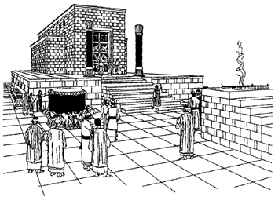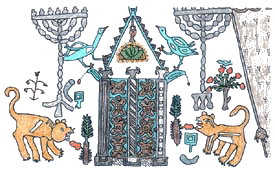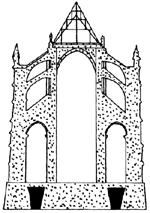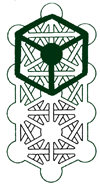Unpacking and publishing the Phaistos Disk since 1993
HOME PREVIOUS NEXT SITEMAP

Chartres Cathedral, built in 1228 CE above an ancient geophysical portal, is the World Soul in stone. (Illus. 1 ) A close examination of the ground plan reveals it. The ground plan design (lower left), in the shape of a Latin cross, is a combination World Soul (lower center) and Limit-Cross. PI, P2 and P3 are great stained-glass windows through which streams The Boundless Light, brilliantly illuminating the interior of the cathedral and enlightening Sacred Center, P4 on the World Soul.
The corners of North and South Transepts are P6 and P9, P5, and P8. In the center of the transepts is hidden P7, below which is Vortex, P10, defined as "Portal" in Kabalism. Below Vortex is Great West Door, P13, defined as "Communion" in Kabalism. Traditionally, when the pilgrims entered the cathedral through Great West Door they proceeded to Vortex.
At the center of the Vortex-Labyrinth was once the combat of Theseus and the Minotaur, but it has been erased over time by the feet of pilgrims. From the outer circle of the Vortex, the pilgrims spun around and around ever inward until they reached its center. After this first Ritual of the Portal, they proceeded into the cathedral, where the portal is erected in the divine proportions of the sacred geometry that comprise the uplifted architecture of the cathedral (bottom right).



131 feet below the pinnacle of the Gothic arch and 131 feet over the ancient geophysical portal floats Sacred Center, P4. Beneath Sacred Center, in the crypt of the cathedral, is a convergence point of telluric energy where is located a dolmen and a well. The dolmen, a megalithic tomb of two standing stones supporting a large, flat boulder, was built about the time
of Stonehenge. The well, called "the Well of the Strong," and the dolmen were once buried within a mound, creating a portal tall enough to walk through. Chartres is the 6th church built over the dolman and the well, the other five destroyed by fire.
Until the 18th century, every pilgrim took part in a second Ritual of the Portal involving descent to the dolmen, where they were blessed with the water from the well. In the 3rd century CE, Christians named this underground sanctuary "Druid's Grotto" because it was believed that a Druid college once stood on this site and that mysterious rituals were held in ancient times.
Chartres is designed according to proportions that obey the law of the Golden Mean, 1.618 (phi). In Chartres, distances between pillars and the lengths of the nave, transepts, and the choir are all multiples of the Golden Mean. The dotted lines of the ground plan (top right), the shape of a golden rectangle, represent the ribs supporting the vaults of the quadrangular units of which the cathedral is composed. The vaults running down the center of the nave and the transepts are much higher than those of the side aisles, and this is true for the portals of the Central Pillar of the World Soul (top right).


Shrouded in mystery is the financing and building of Chartres, involving the Knights Templar, the last order of the Grail Knights. The mystery involves how the Templars found the knowledge, as early as the 12th century CE, to build such a magnificent structure. The answer lies in the quest the Knights Templar undertook in traveling to Jerusalem. They hoped to
gain secret knowledge believed to be held there in the Ark of the Covenant, which was rumored to be buried under Solomon's Temple.
The Ark of the Covenant was a wooden chest (arca) in which the Jews kept the tablets of the Law. In Jewish synagogues and temples, an ark is a cabinet for housing holy scrolls. The Ark mosaic (top right) in Israel at the Beth Alpha Synagogue, built during the Greco-Roman period, portrays the World Soul-Ark of the Covenant as a chest containing the Holy Scrolls of the Law. Above the Ark, the section through a Gothic arch displays the portal supported by buttresses like the Central Pillar of the World Soul supported by the outer pillars. The section, a golden rectangle, confirms all the spheres on the Central Pillar as portals in the Curtain of space-time and energy-matter. The section and the Ark mosaic, both patterned on the World Soul, display the Three Primordial Principles.
Since ancient times (3000 BCE) the three pillars of the Three Primordial Principles have been defined as positive, negative and neutral. With the addition of the third principle, polarity becomes dimensional and gains a plane surface (that which has length and breadth). The plane surface formed by the triangle was called the "plain of truth" by the Pythagoreans of ancient Greece, because it is the Three Primordial Principles expressed in geometry as a triangle. According to the Pythagoreans, the plain of truth is the "hearth of the universe."
Historically, the right pillar (Jachin, the right pillar of Solomon's Temple in Judaism--see above) is defined as positive in Hermeticism; as Male in Kabalism; as Light in Gnosticism; as Endless Light in Zoroastrianism; as Light in Greek philosophy; and as Father of Greatness dwelling in the Light in Manachaeism. The left pillar (Boaz, the left pillar of
Solomon's Temple in Judaism--see above) is defined as negative in Hermeticism; female in Kabalism; Darkness in Gnosticism; or Endless Darkness in Zoroastrianism; Dark in Greek philosophy; and King of Darkness in Manichaeism. The Central Pillar, where the portals are formed, is neutral in Kabalism; Androgynous in Alchemy; Hermaphroditic in Hinduism; Intermediate Spirit in Gnosticism; Void-Negative Space in Zoroastrianism; Air-Fate in Greek philosophy; and Shadow between like a wedge in Manichaeism.
Seen on the Ark of the Covenant mosaic (see above right) is the Curtain. The little crab, bottom right, is a curtain pull (the crab and curtain on the left are not shown here). The crabs, astrological sign of Cancer, pull aside the creating the portal and revealing The Boundless Light, symbolized by the Menorah.
"The veil at first concealed how God controlled the creation, but ... the veil is rent and the images inside are revealed..."

The World Soul-Ark is the structure of all things even as it allows for the revealment of the structure of all things. The Law contained within the Ark of the Covenant is the secret knowledge the Knights Templar sought at Solomon's Temple. It is the knowledge with which they built Chartres Cathedral. This knowledge (gnosis) is the Law of Polarity, the first principle of creation; the plain of truth; and the hearth of the universe.
The Knights Templar then returned to France in 1128 CE, after ten years of study in Jerusalem and began construction of Chartres, the archetypal Gothic cathedral and the World Soul in stone. The word Gothic is said to be derived from the descendants of Jason and the Argonauts who spoke the "langue argotique" (Language of the Argo), this according to the mysterious alchemist, Fulcanelli. The Templars, the first large, community service organization, held communal prayers and services in hospices they founded all over France. Although they took vows of chastity, obedience and poverty, and upheld them, they became immensely wealthy because of estate donations, some of which the Roman Catholic Church would likely have received.
About 200 years after the construction of Chartres, the Roman Catholic Church, assisted by King Philip the Fair of France, condemned the Knights as heretics and burned sixty-four of them at the stake. When the Templars died they refused to give out any of their secret knowledge, even about Baphomet, whom they were accused of worshipping, whom they admitted worshipping and whom they were burned for worshipping. The mystery of Baphomet was solved recently when it was discovered that the Knights knew the Atbash Cipher, a system of cryptography involving the written Hebrew language. Evidence exists indicating that Jesus was familiar with the Atbash Cipher, found in a number of Dead Sea Scrolls.
In the Atbash Cipher, Baphomet decodes itself perfectly into "Sophia," Greek for Wisdom and Gnostic for the Heavenly Partners, the beings that facilitate the communication of the individual souls or sparks of the World Soul. Ironically then, the Knights Templar were burned as heretics for worshipping wisdom and the Holy Spirit.
"Precisely because orthodox religion was defective in the wisdom component, any modality which contained it was, ipso facto, heresy."
When the Knights Templar died, so did the last of the Grail knights. The Templars patterned their brotherhood on the Knights of the Round Table, adopting their high standards of faith, charity and loyalty. The Holy Grail (Crater), for which the mythical Knights of the Round Table searched, symbolizes the Vast Vortex, the Cup or Mixing Bowl stirred by the Creator. The Holy Grail is the portal in the Curtain of space-time and energy-matter--the negative space in a space-time continuum.
In a popular legend of the Middle Ages that arose with alchemical lore, the Holy Grail was a hexagonal emerald in Satan's crown. According to this legend, when Satan opposed God, many of the archangels and angels chose sides, but some remained neutral, refusing to polarize. When Satan fell from grace, tumbling from heaven through the negative space of Daath the abyss, his emerald fell from his crown. The neutral angels recovered the emerald, took it to earth and gave it to humanity, where it became known as the Holy Grail.
Many people in the Middle Ages believed the Grail, the Philosopher's Stone, the Ark of the covenant and the Fountain of Youth all physically exist. Many have gone questing for the Grail in the manner of the Knights of the Round Table. One of the questers in 1099 CE was Guglielmo Embriaco who found in Jerusalem the Sacro Catino or Holy Bowl, 16" diameter and 3-1/2" high. (above left) Compare it with the World Soul geometry and see the similarities. Believing it to be the Holy Grail, Embriaco brought it to Italy and placed it in the Cathedral of San Lorenzo, where kings and clerics contested its ownership. In 1806 Napoleon's army seized the bowl and took it to Paris, where it was subjected to rigorous examination in scientific attempts to confirm it as the Grail. Finally, it was declared to be made from a piece of green glass. The Sacro Catino was badly damaged by the examination, having been shattered into ten pieces. One of the pieces is on display in the Louvre.
Footnotes
 In the Round Table legend, the search for the Holy Grail--an inner quest--ends when the Grail is found. At that moment of attainment, the mortal who finds the Grail unites with Baphomet, the immortal Being on the other side of the curtain who merges with the mortal. With the resultant fusion or alchemy, the mortal acquires immortality.
In the Round Table legend, the search for the Holy Grail--an inner quest--ends when the Grail is found. At that moment of attainment, the mortal who finds the Grail unites with Baphomet, the immortal Being on the other side of the curtain who merges with the mortal. With the resultant fusion or alchemy, the mortal acquires immortality.
Illustrations: All Illustrations are by the author. 1. After Robert W. Nicholson;
Copyright Notice - Disk of the World - Text and images copyrighted March 21, 1993-2025, Claire Grace Watson, B.A., M.S.T., U.S. Copyright and under the Digital Millennium Copyright Act of 1998, All rights reserved. No part of this web page may be reproduced or transmitted in any form or by any means without written permission from the author, except for the inclusion of brief quotations in a review.